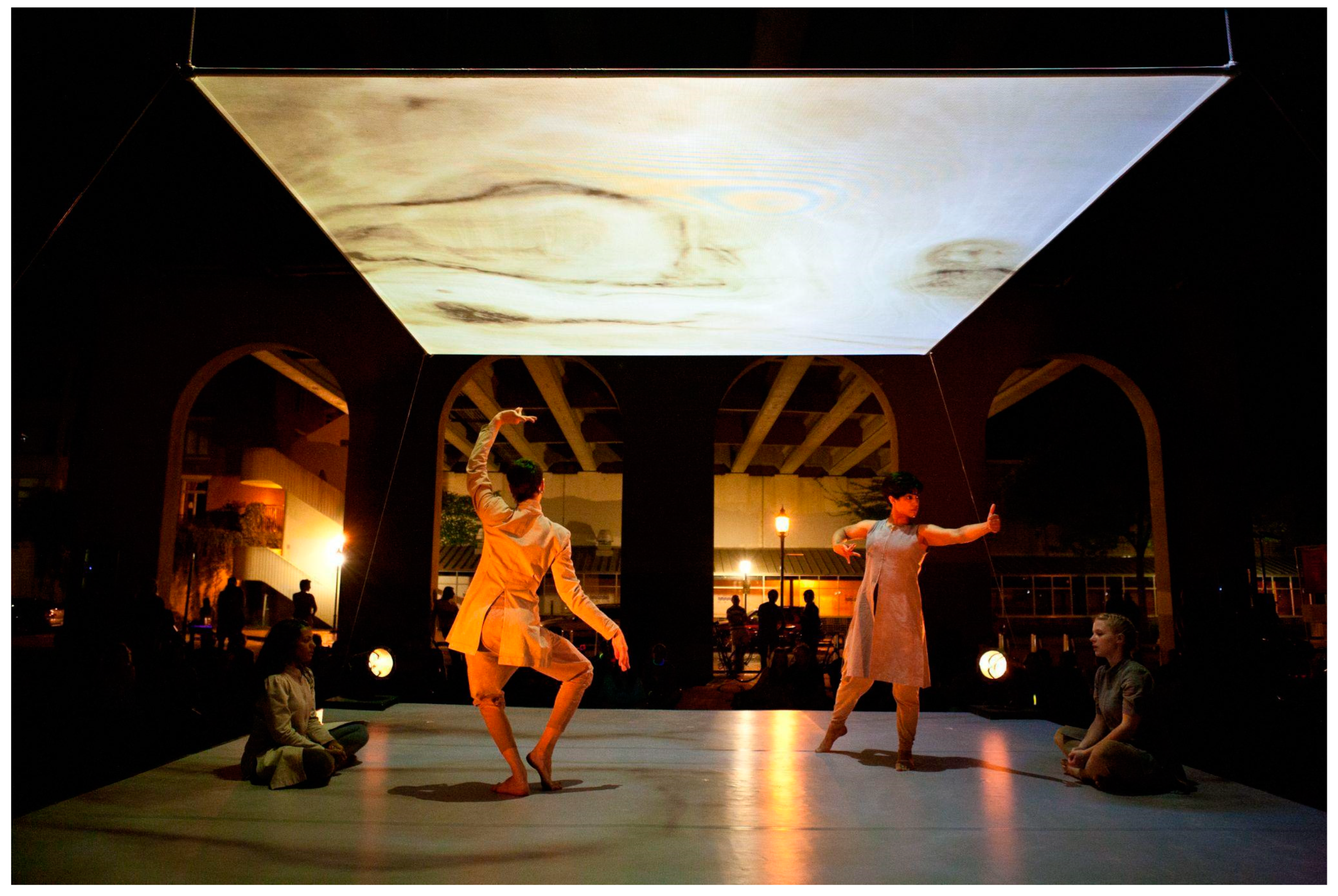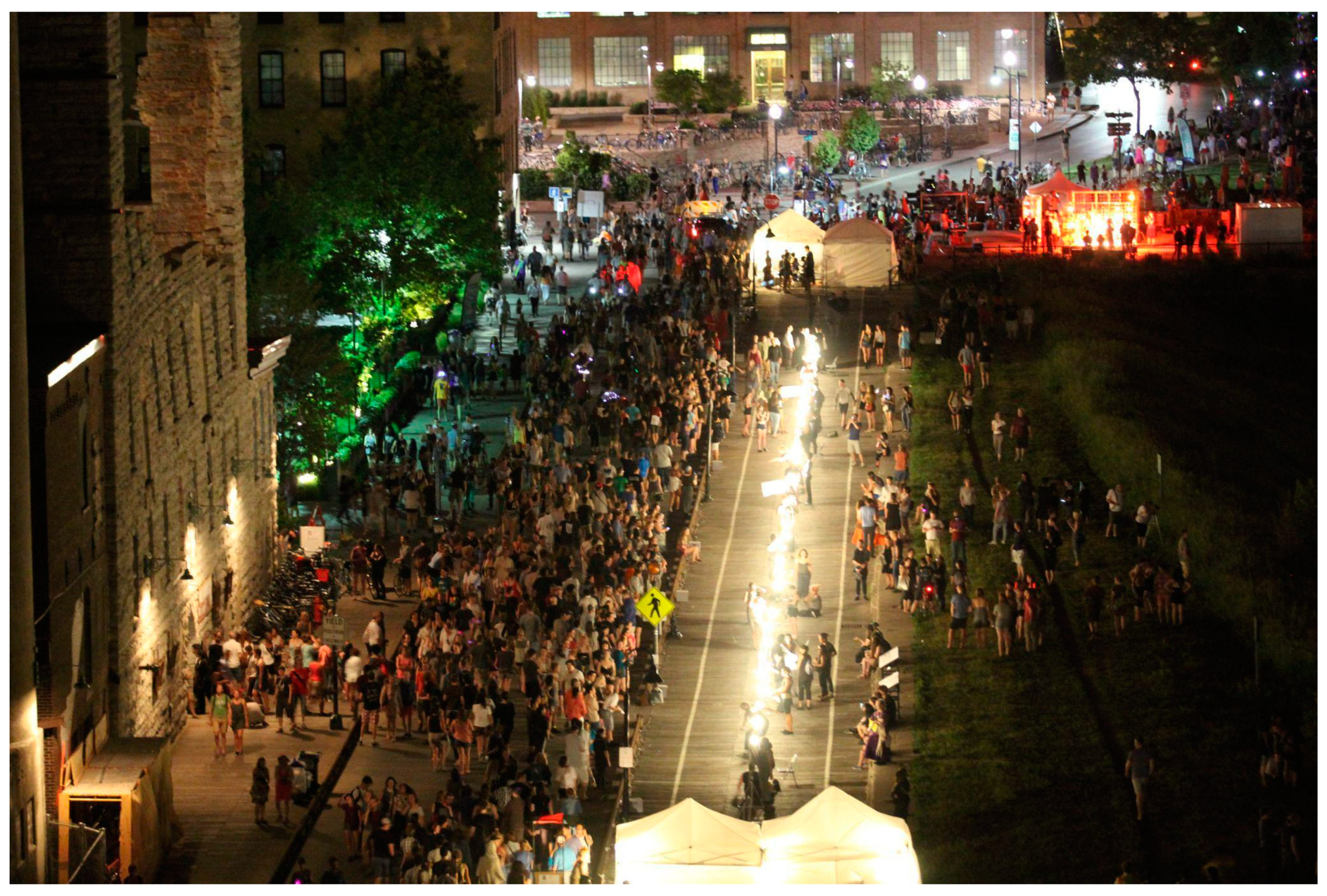My Practice of Re-Patterning My Art
Abstract
:1. Struggles and Complicities in My Artist Journey
2. Towards the Restoration of Personal Health and Artist Practice
3. Repatterning Modalities of Making through Prairie|Concrete
Funding
Data Availability Statement
Conflicts of Interest
| 1 | Aniccha Arts (est. 2004) is a transdisciplinary arts collaborative in Minneapolis/St. Paul, MN, that produces site-specific performances which examine agency, voice, and group dynamics within community histories, institutions, and systems. |
| 2 | Richa Nagar, a friend and an academic who often invites me into her classroom, talks about how we can engage in a path of continuous (un/re)learning and in that way (un)becoming as a social justice practice of being in the world. |
| 3 | Prairie|Concrete is an outdoor embodied movement project that will bring visibility to plant cycles and growing practices through embodied listening and movement sessions with communities in St. Paul, Minnesota. The commission will unfold across three City of St. Paul Public Parks—Frogtown Farm, Hidden Falls Regional Park, and Western Sculpture Park. |
| 4 | Pillsbury House Theatre, originally a settlement house, is a human services and arts institution where I worked as a teaching artist with vulnerable communities and also worked as the program director for Naked Stages, their early career performance development program. |
| 5 | The caste system is a South Asian social hierarchical structure of discrimination originated in Hinduism which is determined by a person’s birth. |
| 6 | In Habit: Living Patterns is a 75 min outdoor performance that was performed in loops continuously for nine hours under the Central Avenue bridge in Minneapolis. This piece is based on 16 “dots” or segments, commenting on different aspects of the collectively-learned habits and behaviors that emerge in everyday life. Each section was an interrogation of the patterns that exist in our bodies and environment. |
| 7 | Upstream Arts is an institution that uses the power of the creative arts to activate and amplify the voice and choice of individuals with disabilities. |
| 8 | Every Other is an Aniccha Arts performance that examines how the body is disciplined through personal, material, spatial, and sociopolitical sites of tension. Featuring a multi-racial cast that moves through an immersive sonic and light environment, this interdisciplinary performance is composed of three movements that explore themes such as the relationship between body and space, the problem of cultural appropriation, and the implications of losing one’s first language. |
| 9 | Census is an outdoor performance that featured 65 performers and hundreds of audience members moving together across 170 yards for 8.5 h at the all-night Northern Spark Festival in Minneapolis. The piece asked: How does systematic information gathering affect the body, our everyday lives, and our broader communities? The cast featured members of historically underrepresented communities especially in terms of race, ethnicity, dis/ability, and gender-nonconformity. By moving together from dusk till dawn, the performers activated and re-articulated this space into a new kind of census, a living document of our own communities. |
| 10 | Parking Ramp Project was a performance installation inside a seven-level parking garage in Bloomington, MN. The project asked questions about transience, migration, and stability in a space that temporarily stores cars and is home to nothing. Performers pervaded the parking structure with their bodies, working against the ramp’s visible slant to find their individual verticality. Questions we asked in creating the work: How do we find softness in a landscape of concrete? What anchors us on these alternating planes? How do we connect across such a complex landscape? |
| 11 | Prairie|Concrete is is an outdoor embodied movement project commissioned by Public Art Saint Paul to take place in three public parks in St. Paul through the summer of 2023. This project will bring visibility to plant cycles and growing practices through embodied listening and movement sessions with surrounding communities. |
| 12 | Western Sculpture Park is a 2 acre neighborhood park located by the state capitol. Public Art Saint Paul curates and maintains the sculpture collection and presents programs in the park. |
| 13 | Frogtown Park & Farm was formed in 2013 as a partnership between the Trust for Public Land, the City of St. Paul and the Wilder Foundation. It was created as a natural area, a recreation area and an urban demonstration farm. |
| 14 | Hidden Falls Regional Park is connected to Crosby Farm by a trail system and borders the Mississippi river with a large biodiversity. There is a small waterfall within this park. |
| 15 | BIPOC stands for Black, Indigenous, People of Color. I use this term since I have met indigenous people who do not identify with the category of ‘people of color’ and this feels like the best option to describe the multiple identities of the Aniccha Arts team working on the Prairie|Concrete project. |
| 16 | Crosby Farm Regional Park is connected to Hidden Falls regional park, home to large biodiversity by the Mississippi river and where you can see the Bdote. |
| 17 | Bdote is a Dakota word referring to the confluence of two rivers, and in this case the Minnesota and MIssissippi rivers. |
| 18 | Fort Snelling is a former military fortification, a primary center for government forces during the US-Dakota war of 1862. |
References
- Vasudevan, Pramila. 2004. Aniccha Arts. Available online: http://www.aniccha.org (accessed on 19 March 2023).
- Vasudevan, Pramila. 2012. “In Habit: Living Patterns”. Aniccha Arts. Directed by Piotr Szyhalski. Dramaturgy by Jasmine Kar Tang. Northern Spark Festival. Minneapolis: Under the Central Avenue Bridge, June 7–9. [Google Scholar]
- Vasudevan, Pramila. 2015. “Every Other”. Aniccha Arts. Directed by Piotr Szyhalski. Dramaturgy by Jasmine Kar Tang. Minneapolis: Grain Belt Bottling House, May 7–9. [Google Scholar]
- Vasudevan, Pramila. 2018. “Parking Ramp Project”. Aniccha Arts. Dramaturgy by Jasmine Kar Tang. Bloomington: Health Partners Parking Ramp, September 29–30. [Google Scholar]
- Vasudevan, Pramila. 2023. “Prairie|Concrete”. Aniccha Arts. Dramaturgy by Jasmine Kar Tang. St. Paul: Frogtown Farm, Hidden Falls Regional Park and Western Sculpture Park, June 7–September 10. [Google Scholar]
- Vasudevan, Pramila, Jasmine Kar Tang, and Piotr Szyhalski. 2016. Census. Aniccha Arts. Minneapolis: West River Parkway, June 11–12. [Google Scholar]





Disclaimer/Publisher’s Note: The statements, opinions and data contained in all publications are solely those of the individual author(s) and contributor(s) and not of MDPI and/or the editor(s). MDPI and/or the editor(s) disclaim responsibility for any injury to people or property resulting from any ideas, methods, instructions or products referred to in the content. |
© 2023 by the author. Licensee MDPI, Basel, Switzerland. This article is an open access article distributed under the terms and conditions of the Creative Commons Attribution (CC BY) license (https://creativecommons.org/licenses/by/4.0/).
Share and Cite
Vasudevan, P. My Practice of Re-Patterning My Art. Arts 2023, 12, 165. https://doi.org/10.3390/arts12040165
Vasudevan P. My Practice of Re-Patterning My Art. Arts. 2023; 12(4):165. https://doi.org/10.3390/arts12040165
Chicago/Turabian StyleVasudevan, Pramila. 2023. "My Practice of Re-Patterning My Art" Arts 12, no. 4: 165. https://doi.org/10.3390/arts12040165
APA StyleVasudevan, P. (2023). My Practice of Re-Patterning My Art. Arts, 12(4), 165. https://doi.org/10.3390/arts12040165




